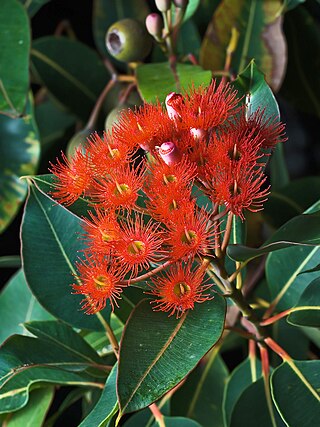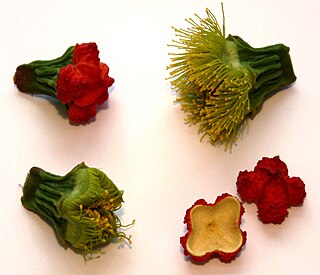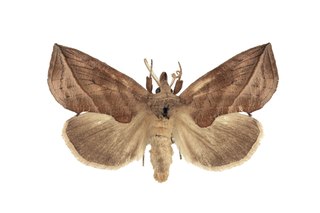
Corymbia, commonly known as bloodwoods, is a genus of about one hundred species of tree that, along with Eucalyptus, Angophora and several smaller groups, are referred to as eucalypts. Until 1990, corymbias were included in the genus Eucalyptus and there is still considerable disagreement among botanists as to whether separating them is valid. As of January 2020, Corymbia is an accepted name at the Australian Plant Census.

Eupomatia is a genus of three species of plants in the ancient family Eupomatiaceae, and is the sole genus in the family. Eupomatiaceae is recognised by most taxonomists and classified in the plant order Magnoliales. The three described species are shrubs or small trees, native to the rainforests and humid eucalypt forests of eastern Australia and New Guinea. The type species Eupomatia laurina was described in 1814 by Robert Brown.

In botany, an operculum or calyptra is a cap-like structure in some flowering plants, mosses, and fungi. It is a covering, hood or lid, describing a feature in plant morphology.

The genus Calyptra is a group of moths in subfamily Calpinae of the family Erebidae. They are a member of the Calpini tribe, whose precise circumscription is uncertain but which includes a number of other fruit-piercing or eye-frequenting genera currently classified in Calpinae.

The Calpinae are a subfamily of moths in the family Erebidae described by Jean Baptiste Boisduval in 1840. This subfamily includes many species of moths that have a pointed and barbed proboscis adapted to piercing the skins of fruit to feed on juice, and in the case of the several Calyptra species of vampire moths, to piercing the skins of mammals to feed on blood. The subfamily contains some large moths with wingspans longer than 5 cm (2 in).

The Calpini are a tribe of fruit-piercing moths in the family Erebidae; formerly they were included in the family Noctuidae. The proboscis of the adult moths of this tribe is pointed and barbed, allowing the moth to pierce the skin of fruit to drink the juice. The vampire moths in the genus Calyptra can pierce mammal skin to drink blood.

Calyptra canadensis, the Canadian owlet or meadow rue owlet moth, is a moth of the family Erebidae. The species was first described by Charles J. S. Bethune in 1865. It is found in North America from Nova Scotia to North Carolina in mountains, west to Texas, north to Saskatchewan, and occasionally Alberta. It is the only insect from the Calyptra genus to habitat North America. Adults of this species feeds on fruit.
Calyptra albivirgata is a moth of the family Erebidae first described by George Hampson in 1926. It is found in Asia, including China and Japan.

Calyptra thalictri is a moth of the family Erebidae. It is native to the area ranging from Japan and Korea to China and Malaysia, west through the Urals to Southern Europe, but it has recently expanded its range to northern Europe. In 2000, it was observed in Finland and in 2008 it was recorded even further west, in Sweden.

Calyptra fletcheri is a moth of the family Erebidae. It has been found in China.
Calyptra gruesa is a moth of the family Erebidae. It has been found in China. C. gruesa has a wingspan range of 25 to 29 millimetres.
Calyptra hokkaida is a moth of the family Erebidae. It has been found in China and Japan. The larvae length of C. hokkaido is roughly 40 millimetres (1.6 in).
Calyptra lata is a moth of the family Erebidae. It has been found in Japan and far-east Russia. The larvae length of C. lata is roughly 45 millimetres (1.8 in).

Calyptra minuticornis, the vampire moth, is a moth of the family Erebidae. It has been found in Indonesia, Java, India, Sri Lanka, and Australasia.
Calyptra subnubila is a moth of the family Erebidae. It has been found in Indonesia.

Calyptra orthograpta is a moth of the family Erebidae. It has been found in China and India. It has been noted to be a relatively rare species.
A calyptra is a feature of plant formation. Calyptra may also refer to:
Yirrkala calyptra is an eel in the family Ophichthidae. It was described by John E. McCosker in 2011. It is a marine, tropical eel which is known from Queensland Australia, in the western Pacific Ocean. Males can reach a maximum total length of 35.8 centimetres (14.1 in), while females can reach a maximum TL of 39.5 centimetres (15.6 in).
Punctapinella paratheta is a species of moth of the family Tortricidae. It is found in Morona-Santiago Province, Ecuador.
Paratheta is a genus of moths in the family Cosmopterigidae.










